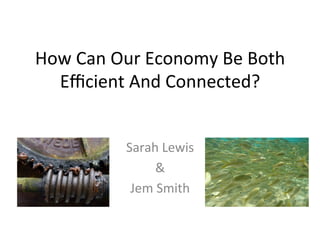
How can our economy both be efficient and connected? (Sarah lewis & Jem Smith)
- 1. How Can Our Economy Be Both Efficient And Connected? Sarah Lewis & Jem Smith
- 2. What does ‘an economy of interconnec@ng strengths’ mean? Ø What does it look like? How similar or different? Ø What economic language can we use? How does it relate to Economics is in crisis. But language of economics why aren’t political now? scientists and sociologists offering an alternative Ø A level of scep@cism... view? Aditya ChakraborJy: The Guardian 17.04.12
- 3. Our @me here together Ø Key current economic terms and assump@ons Ø The pull of the future Ø What apprecia@ve ques@ons can we be asking to help us develop a beJer sense of of the phrase ‘economy of interconnec@ng strengths’? Ø Developing a new, yet connected language to ‘do’ economic talk Ø How do we take it beyond this room?
- 4. What is an economy? An economy is a system to turn raw resources into consumer goods/ services using workers and machines
- 5. What is an economy for? To make people happy. What makes people happy? Consumer goods and services (includes healthcare, educa@on etc.). Two problems: 1 Working oXen makes people unhappy. 2 Resources (coal, oil, land etc.) and inputs (workers and machines) are limited, people’s wants are unlimited.
- 6. Choices must be made • How much should people work? Leisure @me makes people happy but money allows them to buy good/services they need or want. Vs. • What goods/services should be produced with limited resources, and how? Vs. • Who should get these goods/services? Vs.
- 7. How do we decide? The Price Mechanism Prices tell you something’s Opportunity Cost – what you have to give up to enjoy it. This allows society to make these choices. Price is determined by scarcity and desire – supply and demand. Prices don’t lie – usually! Examples If workers are scarce and companies want to use them rather than machines then wages – the price of labour – goes up as supply is low and demand high. Wages are the price of leisure @me. If cars are plen@ful and people prefer bicycles, the price of cars goes down.
- 8. Who decides? All systems use prices to make these choices one way or the other, the ques@on is who uses them and for what purpose? Extremes Socialist Free Market What is produced: What the What is produced: What people government thinks is best for you want Who gets it: Everyone gets equal Who gets it: The most valuable shares people get the most How much should you work: As much How much should you work: As as society needs you to much as you need/want to
- 9. Which economic system is best? Err…. Two ques@ons really: What is the best system for producing goods/services? What is the best system for distribu@ng them? Answer: Which is the most efficient? Which system produces the most of the things which make people happy, and in the way they are happiest with (which is the most produc?vely efficient)? Which system shares out these things in the way which results in the greatest amount of happiness overall (alloca?ve efficiency)?
- 10. Produc@ve efficiency Theory and experience tells us that in this case, the free market is best: Consumers decide what is produced so they are what make people happiest and what they need. People decide for themselves how much to work and so can balance work and leisure. This system has compe@@on, making companies deploy labour and capital efficiently, boos@ng produc@vity. This system encourages technological advances, boos@ng produc@vity.
- 11. Excep@ons – market failure The free market relies on people making ra@onal decisions about what’s best for them – experience and psychology suggests that some@mes they don’t! Health – people underes@mate the value of early interven@on and insurance. Educa@on – you being educated has benefits for others but they don’t pay for it. Street ligh@ng – physically impossible to charge people for the street ligh@ng they use, even though they would willingly pay for it.
- 12. Alloca@ve efficiency There is no consensus on how to allocate goods in the best way for society Depends on how you think people enjoy material possessions… Does a poor man buying his first car get more happiness from it than a rich man buying his third? Yes: A more equal society = a happier society No: A more equal society = no benefit Do people care more about the reality of their current situa@on than the possibili'es for the future? Yes: A more equal society = a happier society (many people beJer off, some worse off today) No: A more equal society = an unhappier society (nobody can dream of being s@nking rich in the future)
- 13. Different Models As long as produc@ve efficiency is maintained, economies can have different alloca@ve models and be equally successful. USA Sweden High growth High growth Highly unequal wealth Very equal society Huge possibili@es ‘The American Less poten@al for riches Dream’
- 14. Exis@ng points of connec@on Ø What connec@ons did you hear to ‘strengths’ language? Ø How could the language of economics move towards the language of ‘an economy of interconnec@ng strengths’? Ø What is pulling us towards a different understanding of economy and economics now and in the future?
- 15. Developing the ques@ons Ø What apprecia@ve ques@ons can we be asking to help us develop a beJer understanding of a world that reflects ‘an economy of inter-‐ connected strengths’ ? Ø How can we take these ques@ons into the world? Ø What resources and strengths do we have to ac@vely par@cipate in changing the understanding of world economy?
